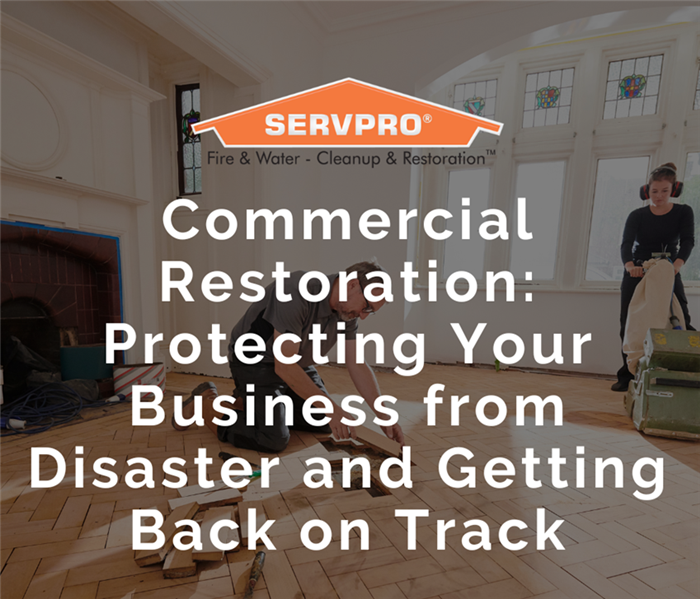Commercial Restoration: Protecting Your Business from Disaster and Getting Back on Track
12/17/2024 (Permalink)
 When a business faces unexpected damage from water, fire, mold, or severe weather, the impact can be overwhelming.
When a business faces unexpected damage from water, fire, mold, or severe weather, the impact can be overwhelming.
When a business faces unexpected damage from water, fire, mold, or severe weather, the impact can be overwhelming. Not only does it disrupt daily operations, but it also affects employees, customers, and bottom-line profits. Commercial restoration is essential for businesses to bounce back quickly after a disaster. Here’s a guide to understanding the commercial restoration process, common types of damage, and how to protect your business for the future.
Why Commercial Restoration Matters
Every hour your business remains closed due to damage is an hour of lost revenue and productivity. The quicker you can address the damage and get back up and running, the less impact it will have on your company’s success. Restoration experts not only handle the cleanup and repair but also ensure a safe and healthy environment, so your team and customers can feel confident returning.
Common Types of Commercial Damage
- Water Damage
- Causes: Burst pipes, roof leaks, flooding, or faulty sprinklers.
- Impact: Water damage can quickly lead to mold growth, structural damage, and ruined inventory or equipment.
- Restoration Process: Water extraction, drying, dehumidification, and monitoring to ensure moisture is fully removed from the building.
- Fire and Smoke Damage
- Causes: Electrical fires, kitchen fires (especially in restaurants), or accidents in industrial spaces.
- Impact: Fire damage is often accompanied by smoke and soot, which can penetrate surfaces and leave behind lingering odors and health hazards.
- Restoration Process: Removing soot, deodorizing, and deep-cleaning, with specialized techniques to prevent further damage to walls, equipment, and furniture.
- Mold and Fungal Growth
- Causes: High humidity, previous water damage, or inadequate ventilation.
- Impact: Mold not only causes damage to walls, floors, and HVAC systems but also poses health risks, particularly in workplaces.
- Restoration Process: Mold containment, air filtration, and removal, followed by steps to prevent future mold issues.
- Storm and Wind Damage
- Causes: Severe weather, including hurricanes, tornadoes, and heavy rains.
- Impact: Damage can range from broken windows and roof leaks to downed trees and flooded basements.
- Restoration Process: Repairs to damaged structures, water extraction, debris removal, and any necessary construction.
The Commercial Restoration Process: What to Expect
Commercial restoration is a comprehensive process that varies depending on the type and severity of damage. Here are the main stages:
- Assessment and Inspection
- Professionals conduct an on-site evaluation, identifying the extent of the damage and creating a customized restoration plan.
- This assessment often includes moisture mapping, air quality testing, and structural inspections.
- Mitigation and Containment
- Swift action is crucial to prevent further damage. Mitigation efforts can include boarding up windows, covering roofs, and placing barriers to contain affected areas.
- For water and mold, this stage involves extracting standing water and setting up dehumidifiers to prevent mold growth.
- Cleanup and Removal
- All damaged materials, from flooring and drywall to furniture and equipment, are removed as needed.
- Soot, ash, mold, and water residue are cleaned using specialized equipment, ensuring that affected areas are safe.
- Restoration and Repair
- This phase involves repairing and replacing damaged areas, from repainting walls to rebuilding parts of the structure.
- Restoration can also include deodorizing to remove any smoke or mold odors, as well as refinishing floors and walls.
- Final Inspection and Prevention Recommendations
- Before you re-open, restoration specialists will conduct a final inspection to ensure the property is fully restored and safe.
- Many professionals also offer recommendations on future preventative measures, such as moisture control or fireproofing upgrades.
Choosing a Reliable Commercial Restoration Partner
When selecting a restoration service, prioritize companies with experience in commercial properties, as they’ll understand the unique challenges that come with business restoration. Look for a team that offers:
- 24/7 Availability: Damage can happen at any time, and the sooner restoration starts, the better.
- Specialized Equipment and Techniques: Commercial properties often require more advanced equipment and processes than residential spaces.
- Experience in Commercial Codes and Regulations: Compliance with local codes is essential, especially in sectors like food service and healthcare.
- Project Management Support: Commercial restoration is complex and may involve coordinating multiple contractors, permits, and inspections. A capable restoration partner will guide you through each step.
Preparing Your Business for Future Disasters
To reduce the risk of severe damage and downtime, consider implementing these preventative measures:
- Regular Maintenance: Schedule routine inspections for plumbing, HVAC, roofing, and electrical systems to catch potential problems early.
- Waterproofing and Drainage Solutions: Seal any cracks in the foundation, ensure proper drainage around the property, and consider water-resistant barriers.
- Create a Disaster Preparedness Plan: Develop a clear emergency plan that includes evacuation routes, emergency contacts, and procedures for securing equipment and data.
- Fire Safety Systems: Ensure all fire alarms, sprinklers, and extinguishers are regularly inspected and meet current standards.
- Insurance Review: Check that your commercial insurance policy adequately covers potential risks and includes coverage for business interruption.
Facing a disaster is a daunting prospect for any business owner, but with the right restoration team and preventive measures, you can protect your business, minimize damage, and recover quickly. Whether it’s water, fire, mold, or storm damage, proactive planning and quick action are key to getting your business back to normal with as little disruption as possible.
As a trusted leader in the restoration industry, SERVPRO of Framingham has the advanced training and equipment needed to restore your business.





 24/7 Emergency Service
24/7 Emergency Service